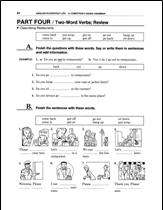1
/
of
1
Work/Life English
D-11.04 Use (In)Transitive, (In)Separable Two-Word (Phrasal) Verbs in Meaningful Contexts
D-11.04 Use (In)Transitive, (In)Separable Two-Word (Phrasal) Verbs in Meaningful Contexts
Regular price
$5.00 USD
Regular price
Sale price
$5.00 USD
Unit price
/
per
Part Four of Chapter 4 (“Food & Things”)—page 64 + Part one of Chapter 8 (“Shopping”) of WorkLife English Grammar 2: English in Everyday Life, pages 121-126. / Part Four of Chapter 4 (“Eating & Drinking”) of WorkLife English Grammar 4: Cross-Cultural Communication, pages 71-72. / Part Three of Chapter 4 (“Earning a Living”) of WorkLife English Grammar 5: Language & Culture in Depth, pages 79-82. / Lessons 77-80 of Chapter 8 (“The Environment”) of WorkLife English Grammar 6: Issues & Answers, pages 133-136.
19 pages
Who It’s For: (Self) Teachers & Helpers at (High) Beginning to Intermediate Language-Proficiency Levels & Beyond
Why It’s Useful: In addition to sentence-core verb-phrasing, instruction in uses of verbs should include verb vocabulary, like “Irregular Verb Parts.” One common subtopic in this area is “Phrasal Verbs,” also called “Two-Word Verbs.” Each of these two– or three-word idioms consists of a verb followed by an adverb and/or a preposition (also called a “particle”) that is an integral part of the lexical item. They can be intransitive (without objects)—like get up or stay awake; inseparable before objects, as in count on [someone] or back out of [a promise]; or separable (Example: bring up [a topic] = bring [a topic] up = bring [it] up.)
Being vocabulary, the subject matter of Phrasal Verbs rarely fills an entire Chapter of a Grammar Text. Here, therefore, is a conglomerate of brief and longer lessons extracted from Levels 2, 4, 5, and 6 of WorkLife English Competency-Based Grammars.
What You’ll Do:
[1] In the 17-page Download, work on one one– to five-page segment at a time. First, either peruse its boxed Grammar-Vocabulary pedagogy—or pick out (three kinds of) Phrasal Verbs in its introductory presentation.
[2] After grasping the concept of (Intransitive vs. Transitive-Inseparable vs. Transitive-Separable) Phrasal Verbs as distinct lexical items, begin acquiring each two– or three-word verb in context. By equating it with one-word synonyms, endeavor to comprehend its literal vs. connotative meanings—and to use it ideally in sentences.
[3] Continue to incorporate phrasal verbs into your receptive and active oral– and written-skills Vocabulary Bank.
Couldn't load pickup availability


